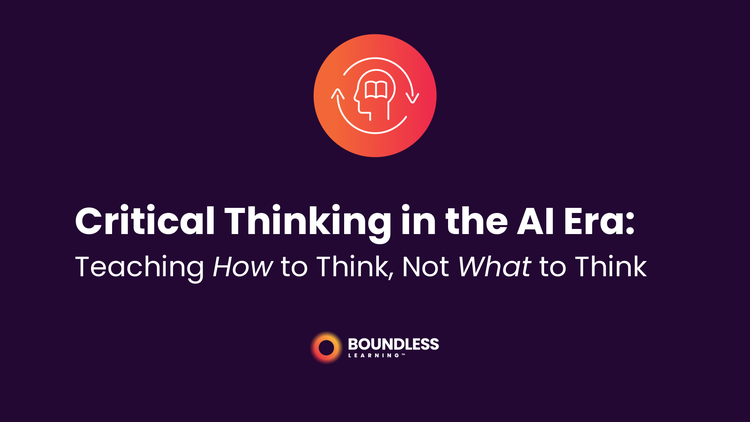Critical Thinking in the AI Era:
Teaching How to Think, Not What to Think

By Caitlin Yolland, Ph.D., Academic Manager (Health)
At Boundless Learning, we work to support learners who are tackling new ideas and developing skills. Given this, it’s important to reflect on how learning can be designed to actively foster critical thinking, encourage meta-cognition, and build curiosity in an increasingly complex world. In the era of generative artificial intelligence (AI), it is more important than ever to ensure we are going beyond expecting rote knowledge acquisition from our learners, and instead nurturing the skills and capabilities required to navigate this rapidly evolving digital world.
Critical thinking in a nutshell
Critical thinking is more than a buzzword, or a skill that we either ‘have’ or ‘don’t have’. Thinking critically involves a set of mental processes that we can apply across all domains of life, and that we continually develop, both ourselves as educators and within our learners.
The ability to think critically aids in decision making, emotional resilience, and simply having a clearer understanding about how we uniquely relate to the world around us[1]. We can practice this skill daily. When thinking critically, we challenge assumptions, consider the quality of evidence, allow ourselves to think flexibly, and practice being open to change.
We consider our own biases, our own automatic thoughts. For example, we can ask: “What other perspectives may there be?” or “How could my own bias be influencing my thoughts and feelings about this, without my awareness?”
By practicing these approaches when engaging with day-to-day problems, ideas, and discussions, we can continue to develop critical thinking as an active mindset, not just a skill to adopt under specific circumstances.
Thinking critically using AI
When it comes to generative AI, critical thinking is critical.
“Machines can crunch data, suggest solutions, or even generate content—but they can’t replicate human judgment, context-awareness, or ethical reasoning. Critical thinking allows us to evaluate AI outputs, question recommendations, and make nuanced decisions. For instance, an AI might generate a marketing copy draft or a summary of research findings—but it takes a critical eye to ensure the content aligns with the unique brand, audience needs, and real-world applicability.” ChatGPT-5, Oct 2025
Honestly, I couldn’t have said it better myself.
In all seriousness, though, AI is already an important part of our day-to-day lives and is influencing the way we acquire knowledge. It has already redefined the way people work and how we understand concepts, across industries.
Educators must adapt quickly to ensure we are building the ability to critically assess the content generated, and how learners can be supported to engage as active participants in the creation of new work rather than a passive user of these helpful tools.
Metacognition: Thinking about thinking
Metacognition refers to the ability to think about our own thinking. It involves being aware of how we learn, process, and apply information. Approaching learning as an enjoyable practice to be undertaken everyday helps in building neural connections and ultimately cognitive growth.
With the development of AI, knowledge is more accessible now than ever, which allows for so many different methods of learning. It is possible to use it to summarise information, in audio form, in visual form, in text form. But there are countless ways to learn even above and beyond this: ask questions, watch a documentary, research a topic, listen to a podcast, chat with friends, take a course.
You are the expert in you. Reflect on how you learn best and allow yourself to embrace learning opportunities that suit your style.
An important element of critical thinking is being open-minded to new perspectives and ideas, being curious and excited to learn.
Enjoying curiosity
Neuroscientific research suggests that when we are curious about new ideas or attain new information, our brain’s reward system is activated. Dopamine is released, meaning the thirst for knowledge can legitimately feel pleasurable and be associated with the anticipation of rewards[2]. High levels of curiosity lead to better complex problem solving, and studies indicate that curiosity can even help protect against cognitive decline as we age[3].
The neuroplasticity of the brain means we can build new neuronal pathways throughout our lifetime of learning. Everyone will explore their own curiosity uniquely, with different intensities and across varied topics.
So, I challenge you to consider this:
How can I embrace my personal sense of curiosity today, and encourage my joy of learning? What am I excited to learn more about?
Applying this curiosity in everyday life engages higher-order cognitive skills, including critical thinking, and overcomes the potential passiveness of learning in this advanced digital environment. In terms of practical application, technical expertise alone can’t guarantee career resilience in this world of generative AI. Critical thinking, metacognition, and curiosity remain fundamentally human skills.
Generative AI is an excellent tool. It’s great at processing information and performing repetitive tasks. However, it can’t contextualise that information, judge nuances, or creatively innovate new ideas in the way we can. Career mobility increasingly depends on integrating technical skills with these higher-order cognitive abilities.
Moving forward, it will be more important than ever for both learners and educators alike to embrace fostering these skills, and to focus learning on how we think, reflect, and question.
About the Author: Dr Caitlin Yolland is an Academic Manger (Health) at Boundless Learning and a Global Wellness Committee Member. She has a Ph.D. in cognitive neuroscience and is passionate about the continuous improvement of online learning in the digital world.